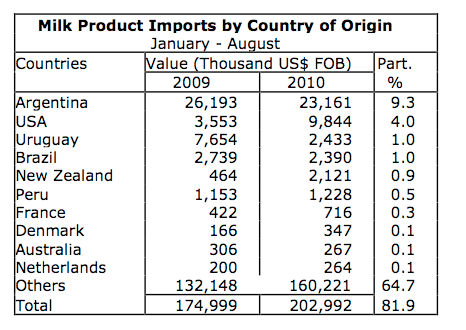



Chile Dairy and Products Annual Reports 2010
Chile’s dairy production this year is expected to increase after a small decrease last year, as weather has been favorable for grass, the basic feed input for milk production, according to the USDA Foreign Agricultural Service.Commodities:
Dairy, Milk, Fluid
Production:
Chile’s total milk output fell 7.8 per cent from 2.55 billion in 2008 to 2.35 billion liters in 2009. Although production had been expanding for the last 5 years, in 2009 output fell approximately 7.8 per cent, mainly due to adverse climatic condition in the primary dairy producing regions of the country, negatively affecting total production. A severe drought in the main milk production areas reduced feed availability and contributed to the fall in output. Another factor that affected total output was significant fall of international milk prices which reduced domestic milk earnings. Over 80 per cent of the milk production herd is fed in grazing fields, supplemental feed is used only by large producers and during the winter months.
International prices of milk, cheese and powdered milk imports increased significantly while domestic milk prices paid to producers fell over 25 per cent in real terms from August 2008 to the same month in 2009. As a result a significant number of producers decided to either reduce or close their milking operations. Industry sources report that the number of milking cows send to the slaughter houses has increased 50 per cent during the first 8 months of 2009.
Despite this contraction in the national dairy herd, the industry reports an increase of 7.2 per cent in total milk received the first eight months of 2010, when compared to the same period of last year. Exceptional meteorological conditions during the summer of 2010 (January through March) with enough rain and sun during spring and summer favored grass production for direct grazing and feed conservation (mainly silage) for the winter months explain this increase.

During the first semester of 2009, milk producers requested the GOC to impose a surcharge of 31.5 per cent on imports of Gouda cheese and whole powdered milk, as imports of these milk products increased significantly during the first 8 months of 2009 when compared to the same period of 2008. Gouda cheese imports increased 72 per cent and powdered milk expanded 344 per cent from 2008 to 2009, coming mainly from Uruguay and Argentina and at a lower than at that time prevailing international prices. Finally, during the first week of October the GOC announced the application of a safeguard of 15 per cent on imports of whole powdered milk and Gouda cheese. The temporary safeguard was extended until January, when the Commission of Distortion decided not to apply a final figure and the safeguard was not extended.
Chile currently has an estimated 16,000 dairy farmers with approximately 650,000 cows in production, of which 80 per cent are considered small producers and the whole dairy industry employs directly and indirectly an estimated 35,000 persons.
Trade:
Latin American countries are the main destination for Chile’s dairy exports, headed by Mexico with a 36 per cent and Venezuela with a 16 per cent of total dairy exports. Close to 40 per cents of these exports correspond to whole and non fat dry milk.

Once again Argentina was the main supplier of dairy products for 2009. The US has become Chile’s second most important dairy products supplier.

Further Reading
| - | You can view the full report by clicking here. |


